Exercises (88)
Abduction and adduction of the legs as well as lateral raising and lowering of the arms in the jump (jumping jack) / knee lift (skipping) ► jumping jack / high knees
Increase pulse
Individual work
Two exercises are performed in constant alternation to increase the heart rate:
running in place, whereby the intensity is constantly varied and the knees are occasionally raised to the height of the navel (skipping). In the other exercise, from an upright position (feet almost together), the legs are spread out to the side while hopping (jumping) and then brought back together to the starting position. As you spread your legs apart, simultaneously raise your arms, which are stretched out and resting against your body, over your head (holding them up). When closing the legs, the arms are brought back to the body. The movement is colloquially known as a jumping jack.
Variant:
Integrate other intensive exercises: Jumps in place (pull your knees up to your chest each time), alternating squats and stretch jumps, alternating push-ups and stretch jumps, etc.
No material required
Abduction and adduction of the legs and lateral raising and lowering of the arms while jumping ► jumping jack Pictures to follow
Increase pulse
Individual work


Stand upright (feet almost together), spread your legs out to the side while hopping (jumping) and bring them back together in the starting position. As you spread your legs apart, bring your arms up over your head (holding them high). When closing the legs, bring the arms back to the body. The movement is colloquially known as the jumping jack.
No material required
Air-Bike
Increase pulse
Individual work
At first glance, the air bike looks similar to a bicycle ergometer or a spinning bike. However, the difference lies in the fact that not only the legs but also the arm and core muscles are used, as these are required for the movement of the air bike. As the handles are pulled along with the hands, the legs and arms move simultaneously.
As the name suggests, the special feature of the air bike is the air resistance. The intensity of the training is regulated solely by the air resistance. The faster the pedalling movement, the greater the air resistance, and therefore the more strenuous the training. On the one hand, this ensures intuitive operation of the device, which is an additional fun factor for many athletes, and on the other hand, the air resistance ensures that the joints are protected.
The device can be ideally used at the end of the warm-up to really push up the heart rate of the exerciser for a short time (e.g. 6-8 x 15 sec. load and break phase or 3 x 30 sec. load with 1 min. break).
1 Air-Bike
Roping up
Increase pulse
Group work
4-6 participants per group
Each participant is equipped with a rope. On a start command, the first runner in the group runs to the wall bars and attaches their skipping rope there (marked with a ribbon). He then runs back to the group and triggers the next runner (e.g. handshake after running behind the group). This runner then attaches his rope to that of the person in front of him. Which group is the first to attach all the ropes together? At the end of the relay, the sports director checks the tensile strength of the knotted ropes.
Per participant:
1 skipping rope
Per group:
1 play bar
1 wall bars
Supply balls
Increase pulse
Group work
2 teams
One group has its goals (e.g. vaulting box elements, tyres or soft mats) in the corners of the pitch, the other group in the middle of the pitch. The aim is to put as many balls as possible into the opposing team's goal by taking the balls from their own goals. Only one ball may be carried per run (if necessary, define the method of transporting the ball: carrying, bouncing, dribbling or rolling). Which group has fewer balls in the goal after a certain time?
8 Swedish box parts
x balls (various)
1 stopwatch
Ribbon relay
Increase pulse
Group work
4-5 participants per group
One runner runs around a turning point (e.g. colouring stick, marker cone or cone) or to the hall wall and back before handing the ribbon to the next runner and sending them on their way. There are various ways of practising with the ribbon:
Single run:
- Clamp the ribbon between the knees
- Clamp the ribbon between the feet and move around hopping
- Carry the ribbon on your chest without holding on to it with your hands
With a partner:
- One participant in the push-up position places their feet on the ribbon, which their partner is holding (garette) and moves away with their hands. The participant who kept their feet in the air with the ribbon becomes the next runner (push-up position) at the handover
- Tuck the ribbon back to back
Replacements: Run around the waiting group back to the next runner for the game ribbon handover - pass the game ribbon forwards between the legs - pass the game ribbon forwards over the heads
.Per group:
2 colouring sticks
1 game ribbon
Basketball relay
Increase pulse
Group work
5-6 participants per group
The distance to the basketball hoop is the same for all groups. The first participant in each group bounces to the basket, where they sink the ball (until successful). He then runs behind his own group. The ball is passed in a snaking line (once over the head, once between the legs) to the foremost participant, who starts as soon as he has received the ball. Once all participants in the group have hit the basket (once or several times), the group sits down.
Per group:
1 basketball
1 basketball hoop
Basketball pursuit
Increase pulse
Group work
5-8 participants per group
The participants line up at the free-throw line in a single collone, with the two foremost participants in possession of the ball. The first participant throws the ball from the free-throw line to the basket. If he scores, he immediately passes the ball to the next participant in the column without the ball. Otherwise, he throws the ball at the basket in compliance with the baseball rules until a hit is made before he can hand the ball to the next thrower. From the first throw of the person in front, the second participant may also attempt to score a basket with the ball. If the person in the back makes a successful attempt faster than the person in front, the person in front is eliminated. If the person in front scores first, the game continues and the ball is passed to the next thrower until the person in front is overtaken by the person behind. At the end of the game, only two throwers duel, who take the ball again after a successful basket shot and, starting from the free throw line, try to catch up with the person in front. As soon as a winner has been chosen, all participants line up again in the column (if necessary according to the ranking of the preliminary round) to start a new round. The sports director may define an additional task for participants who have already been eliminated (e.g. wall sit, global forearm support, side support).
Per group:
1 basketball hoop
2 basketballs
Biathlon-Stafette
Increase pulse
Group work
5-6 participants per group
The participants run around a turning point (e.g. drawing stick, marker cone or cone) or touch a wall and have to fulfil a throwing task on the way back (hitting a target from a certain distance). Each participant carries the throwing object with them during the run. If the throwing task is not completed, the route to the turnaround point (to the wall) must be completed again before returning to the group and the next participant can start running. In the event of a successful attempt, the runner can run directly to the group.
The thrown object is picked up and carried by the runner both in the event of a hit and a miss.
Possible targets:
- Upside-down box
- Ripe
- Mat
- Painting stick
Possible throwing object:
- Ball
- Indiaca
- Howler
- Frisbee
- Maturity
Variant:
Change the distance between throws or the number of attempts.
Per group:
2 colouring sticks
1 target
1 throwing object
Boardball
Increase pulse
Group work
2 teams
Two teams play against each other in a limited playing area. A point is scored when a pass via a basketball board (alternative: defined zone on a wall) is caught by a teammate. Bouncing with the ball is not allowed and the number of steps with the ball is limited (e.g. maximum 3 steps)
Optional: change of possession when the ball falls to the ground
2 basketball hoops/walls with a defined target zone
1 ball (e.g. basketball, handball, volleyball, football)
4 marking cones/caps ►court boundary (optional)
x game ribbons/bibs ►team identification
Boardball
Increase pulse
Group work
2 teams
Two teams play against each other in a limited playing area. A point is scored when a pass via a basketball board (alternative: defined zone on a wall) is caught by a teammate with the racket.
The following rules apply to the game form:
- The ball, which is balanced on the racket, may be carried a maximum of 4 steps and must then be passed immediately.
- The ball may be touched a maximum of 4 times before it is passed on.
- The ball at rest on the racket, without movement of the player, may be held for a maximum of 4 seconds.
- The ball may not be covered with the racket or body, but must be passed on immediately.
- The ball may not be covered with the racket or the body, but must be played on immediately.
- It is not permitted to actively play the ball with the foot or lower leg, with the hand, the arm or the head (free hit).
- If the ball leaves the playing field, it is put back into play by a free hit by the opposing team at the place of action.
Per participant:
1 racket ►smolball
2 basketball hoops/walls with a defined target zone
1 ball ►smolball
4 marking cones/caps ►court boundary (optional)
x playing ribbons/shims ►team identification
Boardball
Increase pulse
Group work
2 teams
Two teams play against each other in a limited playing area. A point is scored when a pass via a basketball board (alternative: defined zone on a wall) is caught by a teammate.
The following rules apply to the game:
- The ball may only be handled with a stick. A player may hold the ball in the basket for a maximum of 5 seconds.
- If a ball lands out of bounds, the player who puts the ball back into play can either run into the court with the ball or play a pass from the sideline (observe the 5-second rule).
- If the ball falls to the floor, players have the option of picking it up with their stick or "covering" it. To cover the ball, cover it with the basket of the stick. After covering the ball with the basket, the opponents must keep a distance of 3 metres and the player with the ball must make a pass (it is not possible to continue running after covering).
- An attack must be executed within 30 seconds.
- Intercrosse is played without contact between body/body and body/stick.
- The player with the ball may only run or stand (star step allowed). Walking is prohibited. When running, the stick must be held in both hands. Catching, throwing or "covering" is permitted with one hand.
- The ball may not be touched with the hand.
Per participant:
1 stick ►intercrosse/lacrosse
2 basketball hoops/walls with a defined target zone
1 ball ►intercrosse/lacrosse
4 marking cones/caps ►court boundary (optional)
x game ribbons/bibs ►team identification
Letter relay
Increase pulse
Group work
4-5 participants per group
There are numerous letter tokens (letters face down) at the turning point, which are available to all groups. The runners each pick up a token (it is not possible to swap) and bring it to the group. If there are no more tokens available or after a time limit set by the sports leader, the groups have 2 minutes to form (correct) words. Each letter used for a word is worth one point. Which group scores the most points?
Variant:
Which group is the first to have all the necessary letters to form a word defined by the sports instructor? In this variant, the token is looked at at the reversal point, if it can be used, it is taken to the group. If the letter cannot be used (already present in the solution word), the token is left behind and the group returns to the group without a new letter before sending the next runner off to the tokens with a handshake.
Stopwatch
x letters/tokens
Alternating extension and flexion of one leg while standing (knee raise in place / skipping) ► run in place with knee raise (high knees)
Increase pulse
Individual work
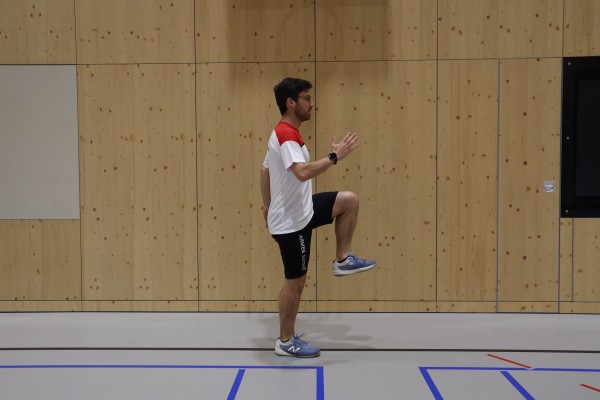
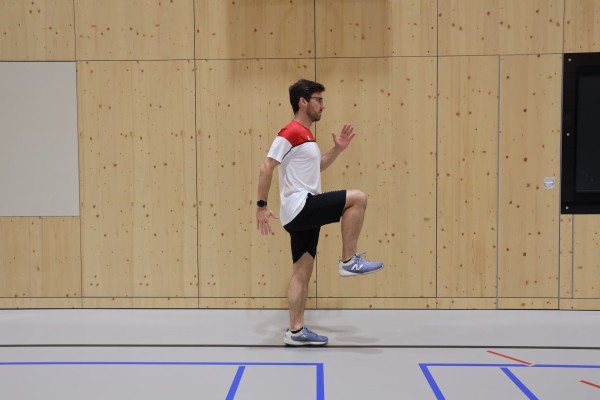
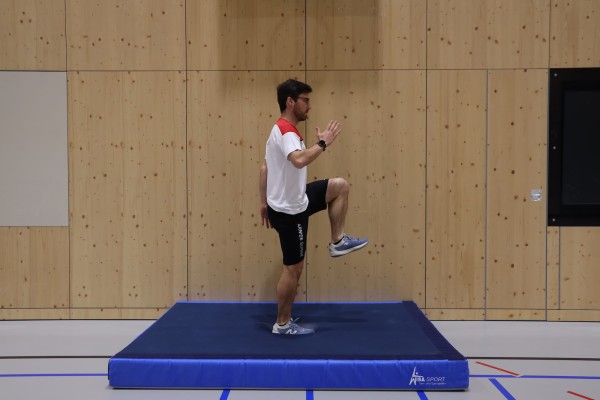
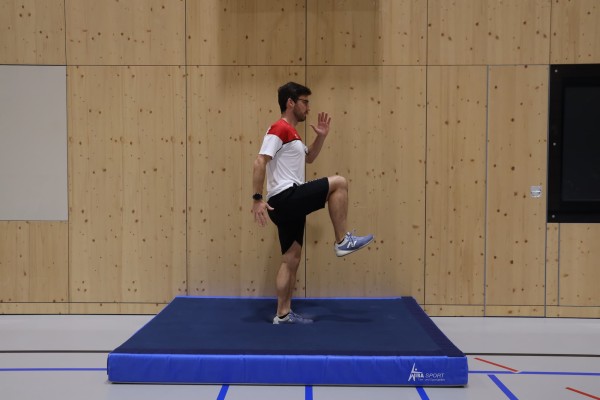
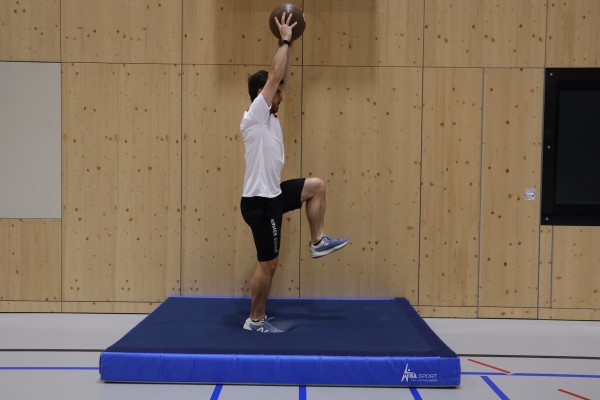
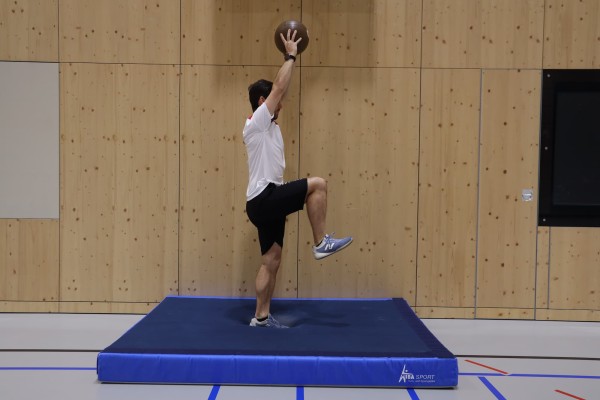
Stand upright and hip-width apart (starting position, then one leg always moving freely), alternately lift one knee straight up to navel height and lower it back to the standing position, swinging your arms along and supporting the movement (knee lift in place). The rhythm/intensity can be varied.
Lighten:
Without mat
Harden:
With weight in top-hold position
Variant I:
Execute the movement very slowly and linger briefly in the one-legged stance to further improve your balance.
Variant II:
Arms folded behind the head, elbows crossed towards the raised knee.
Variant III:
Knees turned out to the side when lifting, arms swinging more to the side.
1 medicine ball / weight plate ► make the exercise more difficult (additional weight)
Memory relay
Increase pulse
Group work
4-5 participants per group
A solution sheet (e.g. key words, a section of a poem, rules of the game, grade badges, etc.) is placed at the turning point of the relay. The runners run to the solution sheet and memorise as much information as possible so that it can be transferred to an answer sheet at the start. The next runner is therefore well advised not to start immediately, but to communicate with the previous runner in order to organise the solution process as ideally as possible. The group that is the first to complete the answer sheet correctly or is furthest along with the solution after a certain time wins the relay.
Per group:
1 solution sheet
1 answer sheet
Writing materials
Goaltime
Increase pulse
Group work
2 teams
The teams collect points by throwing the frisbee through a goal and a teammate catches the disc in the zone behind the goal. At the start of the game, one player from each team stands behind the clear line, where the frisbee is thrown into the air by the sports director. All other players spread out in the playing area. Whoever catches the disc has the right to attack on their side and now passes the frisbee into the field to a teammate. If a pass is made through the goal arc and the disc is caught within the catch zone, the team is awarded one point. Two points are awarded if the pass is made from behind the clear line.
After a successful attack, the frisbee remains in possession, but must first be played behind the clear line before the next attack can be attempted. Likewise, after a turnover (frisbee falls to the ground, frisbee or player leaves the field of play or a pass attempt is intercepted), you must first cross the clear line before you can go on the hunt for points.
A bar with offset uprights (a handball goal without a net or two high jump poles/mobile net stands with a rope as a crossbar) can be used as a goal arch. The catch zone can be defined with cones, colouring sticks or marker cones. The clear line should be approx. 15-20 metres away from the goal.
1 frisbee
x bibs
6 cones
1 bar (or similar as a goal)
Indoor cycling
Increase pulse
Individual work
Indoor cycling involves cycling indoors, whereby the workout on the indoor bike is even slightly more efficient than cycling outside. Whether for burning fat, strengthening the cardiovascular system, ergo for health or for the muscles, training with the indoor bike offers a holistic workout and entails hardly any risks. This holistic workout makes indoor cycling ideal for getting the heart rate up at the end of the warm-up. A high basic speed can be selected or constant changes of pace provide the necessary intensity.
1 Fahrradergometer/Indoor-Bike/Spinning-Bike
Jass card race
Increase pulse
Group work
4-5 participants per group
Each group has a set of Jass cards (cards face down) at the turnaround point. The runner may only take certain cards there that have been defined by the game master (e.g. red or black cards). Otherwise, the card is placed face down again and the runner returns to the group without a card to send the next runner onto the course with a handshake. Which group is the first to have collected all the cards provided (18 cards) or the most cards after a certain time?
Variant I:
The criteria are made stricter by only collecting a certain colour (e.g. all heart cards, only pictures of a certain colour).
Variant II:
The runners collect a card of their choice in each round, which is used to build card houses at the starting point. Which group is the first to have built 5 card houses or the most card houses after a certain time (1 house consists of a total of 7 cards)?
Variant III:
Four groups are formed and each team is assigned a colour (diamonds, hearts, spades, clubs). Only 1 set of cards is used. The respective runners of the groups run to this set and turn over a card. They may only take the revealed card with them if it matches the colour of their group. Otherwise, they run back to the group without a card to send the next runner onto the course with a handshake. Which team is the first to collect all the cards of their colour?
1 stopwatch
Per group:
1 set of jacket cards
Knee lift (skipping) / jump in place incl. knee to chest jump ► high knees / high knee jump (knee to chest tuck jump)
Increase pulse
Individual work
Running very quickly on the spot, with the knees raised to at least the level of the navel (skipping). At a signal from the instructor, the participants perform a few jumps on the spot. The knees are also brought to the chest during the jumps. After the jumps (3-5x), continue with fast skipping.
Variant:
Replace the jumps with other short, intensive exercises (e.g. quick jumping jacks or a push-up and a stretch jump on the signal).
No material required
Run Bingo
Increase pulse
Group work
4-5 participants per group
Each group has a bingo card at the starting point. At the turning point there are corresponding number cards (numbers face down). The runners each pick up a number card (it is not possible to swap) and bring it to the group. The number card is placed on the corresponding field of the bingo card at the starting point. Which group is the first to have a complete row (horizontally, vertically or diagonally)?
Per group:
1 bingo card (5x5)
25 number cards
Running memory
Increase pulse
Group work
4 groups
A large rectangle laid out with marker cones serves as a circuit. A set of memory cards is laid out in each corner. A group positions itself in each corner. At the start of the game, each group may reveal two cards from their set. If they match, two more may be revealed. Otherwise, the whole group has to run a lap around all the marker cones. Which team is the first to find all the pairs?
Variant:
Specify the type of movement (e.g. forwards, backwards, hopping on one leg, crab-walking, etc.).
4 sets of memory cards
4 marker cones
Living stopwatch
Increase pulse
Group work
2 teams
A team transports game ribbons (or balls) from one side of the pitch to the other. The sports director can specify the method of transport (e.g. pinch the ribbon between the knees, pinch the ribbon between the feet and move by hopping). Only one ribbon may be carried per run. This team defines the time available for the other team to score points. As soon as all the game ribbons have been transported to the other side, the run ends and the teams swap roles. There are various ways to collect points:
Throwing task:
- Hitting a basketball hoop from outside the trapeze
- Throwing a Frisbee from a long bench
- Throwing tennis balls into a box
Strength exercise:
- 10 push-ups, 10 trunk bends and 10 stretch jumps = 1 point
- 50 x rope jumps = 1 point
Course:
- Complete obstacle course. 1 lap = 1 point
- Complete the running lap. 1 lap = 1 point
x game ribbons (or balls)
Living stopwatch
Increase pulse
Group work
2 teams
Half of the participants line up in the centre of a square equipped with a rope (jumpers). The remaining participants spread out evenly in the corners of the running lap (runners). At a signal from the sports director, the first runner starts to the next corner, where he sends the second runner onto the course with a handshake. He in turn joins the waiting group at the back. The runners run until each participant is back at the starting point, thereby setting the time available for the rope jumpers in the centre of the square. From the start command, the jumpers in the centre count their jumps. They collect points for their team for each revolution of the rope (e.g. 20 jumps = 1 point).
Which team scores more points in their round?
For half of the participants:
1 skipping rope
4 cones
Living stopwatch
Increase pulse
Group work
2 teams
Half of the participants line up in the centre of a square in two columns of one, facing each other and equipped with a ball (passers). The remaining participants spread out evenly in the corners of the running circle (runners). At a signal from the sports director, the first runner starts to the next corner, where he sends the second runner onto the track with a handshake. He in turn joins the waiting group at the back. The runners run until each participant is back at the starting point, thereby setting the time available for the passers in the centre of the square. From the start command, the foremost passer in the column passes the ball to the player on the opposite side. After the pass, he runs to the other side and stands behind the waiting group. Each complete pass by foot or hand (the sports director may define rules such as Ground pass or receiving the ball between two specific lines) scores one point. Which team scores more points during their pass?
Variant I:
Define different ways of transporting the ball for the group in the centre (instead of passes):
- Ball (e.g. medicine ball or gym ball) medicine ball or gymnastics ball) in a high hold
- Transport the ball on your thighs in a four-footed gait
- Tuck the ball between your feet and bounce
Variant II:
The runners carry/lead a ball and pass it to the next runner in the corner:
- Bounce the ball
- Dribble the ball with their feet
- Roll the ball with their hands
1 ball (football, volleyball, basketball or handball)
4 cones
1 medicine or exercise ball
1 additional ball
Ladder relay
Increase pulse
Group work
4-6 participants per group
One ribbon per team is attached to the bottom rung of the wall bars. The first participant in the group runs to the rung, removes the ribbon and attaches it one rung higher. He then takes over from the next runner, who in turn attaches the ribbon higher up. Which group attaches the ribbon to the top rung first?
Variant:
Hanging the ribbon from the bottom to the top and back to the starting position)?
For each group:
1 play bar
1 wall bars